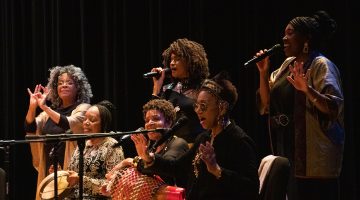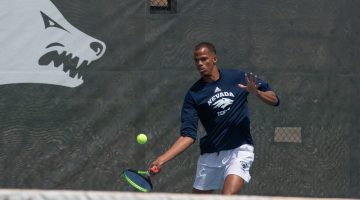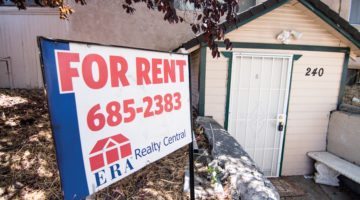
Photo courtesy of Sadie Fienberg
Brandon Boone (left) and Jacob Springmeyer (right) pose for a photo after their electoral win on Thursday, March 10 inside the Mathewson-IGT Knowledge Center. The new president and vice president-elects of the Associated Students of the University of Nevada each won their races with a majority of the vote.
By Jacob Solis
After a full month of campaigns, replete with all the campaign staples — buttons, signage, barbecues and patriotically colored T-shirts — the results are official and ASUN election season is over. Brandon Boone and Jacob Springmeyer have come out on top, winning president and vice president, respectively.
In addition to those executive positions, 21 students were elected to form most of the coming 84th session. One seat in the Interdisciplinary programs remains open and only one of two incumbent candidates running for re-election made it back into the senate for another session. Two colleges, the College of Engineering and the Division of Health Sciences, had uncontested races where all candidates running secured a seat.
The announcement itself was tense. The standard din of casual conversation disappeared with the appearance of Dalton Mack, the chair of ASUN’s Election Committee. A little more than 40 candidates, in addition to a couple dozen observers, waited with bated breath to hear Mack read aloud names, vote counts and winners.
After the announcement, the celebrating began and the new president-elect was at a loss for words.
“Man, never thought this would happen two years ago, but it did,” Boone said. “I’m kind of speechless right now, I don’t know what more to say.”
Boone, a current senator for the College of Business, had racked up numerous endorsements prior to his win, everybody from current ASUN President Caden Fabbi to The Nevada Sagebrush. Despite that, Boone’s challenger, Marissa Crook, only trailed him by 283.
That small number of votes was crucial, however, as only 13 percent of UNR undergraduate students showed up to the polls. It was a 6 percent drop from last year’s record 20 percent turnout, and a large ways away from ASUN Elections Committee Chair Dalton Mack’s goal of 25 percent. The low numbers mean that those 300 votes translate to almost 14 percent of the total turnout. The final count had 56 percent of the vote for Boone, 42 percent for Crook.
Springmeyer’s victory was more sound, winning almost 73 percent of the vote. In fact, Springmeyer was able to drive a larger turnout to the vice presidential race than its presidential counterpart, as roughly 100 more people cast their vote for VP.
Perhaps the first clue that turnout for the general would be low was an equally low turnout for this year’s primary election. The first primary in three years, a little less than 14 percent of UNR undergraduates turned up to vote. Mack hypothesized that this was one of the underlying factors for a low turnout in the general.
“Having four candidates [in the primary], maybe a number of voters were only voting strictly because of their presidential candidate that they wanted, and when we narrowed it down to two …” Mack said, punctuating his sentence with a shrug.
This year’s low turnout, in both the primary and the general, may have actually been in the cards all along. In 2013, turnout in the general almost exactly mirrored turnout in the primary. Thus, it is less surprising that the same would happen in 2016.

Data from the Associated Students of the University of Nevada, graph by Jacob Solis/Nevada Sagebrush
Looking at turnout over time, the average has always been fairly low, hovering around 12 to 13 percent. Even so, voter turnout in most elections is generally always low among 18-to-35-year olds, hovering around 18 percent on average and dipping as low as 12 percent in a non-presidential election year, according to the Census Bureau.
The thing is though, this year’s turnout, for both the primary and the general isn’t so much low as it is average. Across the last 15 years of general elections, average turnout is nearly 13 percent exactly. On top of that, there are only three years when turnout ever exceeded 14 percent and only two years where it fell below 10 percent.
All in all, while turnout for ASUN elections is trending up, it’s only doing so slowly, at least on average. High turnouts, like 19 percent in 2011 and 20 percent in 2015, are most likely outliers caused by election-specific factors, such as last year’s now-infamous “Don’t Vote for Royce” campaign.
In that campaign, sixth-year senior Royce Feuer ran against then Speaker of the Senate Caden Fabbi for ASUN’s top executive job because he wanted to keep the race competitive. Without Feuer in the race, Fabbi would have run unopposed.
“Imagine you are 6 years old, and your mom says we are going to Denny’s for dinner,” Feuer said in a 2015 interview with The Nevada Sagebrush. “Now, you like Denny’s, but the fact that your mom made the decision for you leaves you unsatisfied.”
The end result of this sentiment was a tightly run campaign, complete with towering 7-foot-tall signs painted bright yellow and red, emblazoned with the slogan “Don’t Vote for Royce.” Add to this slickly produced videos that spread like wildfire on social media, and it all drummed up interest in the election that wouldn’t have been there otherwise, according to current ASUN Attorney General Ryan Hood.
“We can’t say for sure what may or may not have caused [the low turnout this year], but I think Royce making the campaign season — not a joke, but making everything lighthearted and comical — made people want to be a part of it,” Hood said.
There were also unique electoral circumstances in 2011, the other outlier in the data set. It was that year that ASUN began allowing students to vote online on WebCampus for the first time. Coupled with massive looming budget cuts, a boost in younger underclassmen voters and non-traditional students pushed turnout up to 19 percent.
In the end, Mack and Hood are still pleased with the election overall, if not a little disappointed by turnout. Though charges have yet to be finalized for campaign violations, Hood called them minimal and assured that they did little to interfere with the integrity of the campaign.
“I’m a little bummed about the voter turnout, but besides that, I think that the candidates did really great,” Mack said. “Of my four years here, this is some of the best campaigning I’ve seen. All of the candidates were getting real creative.”
Jacob Solis can be reached at jsolis@sagebrush.unr.edu and on Twitter @TheSagebrush.











